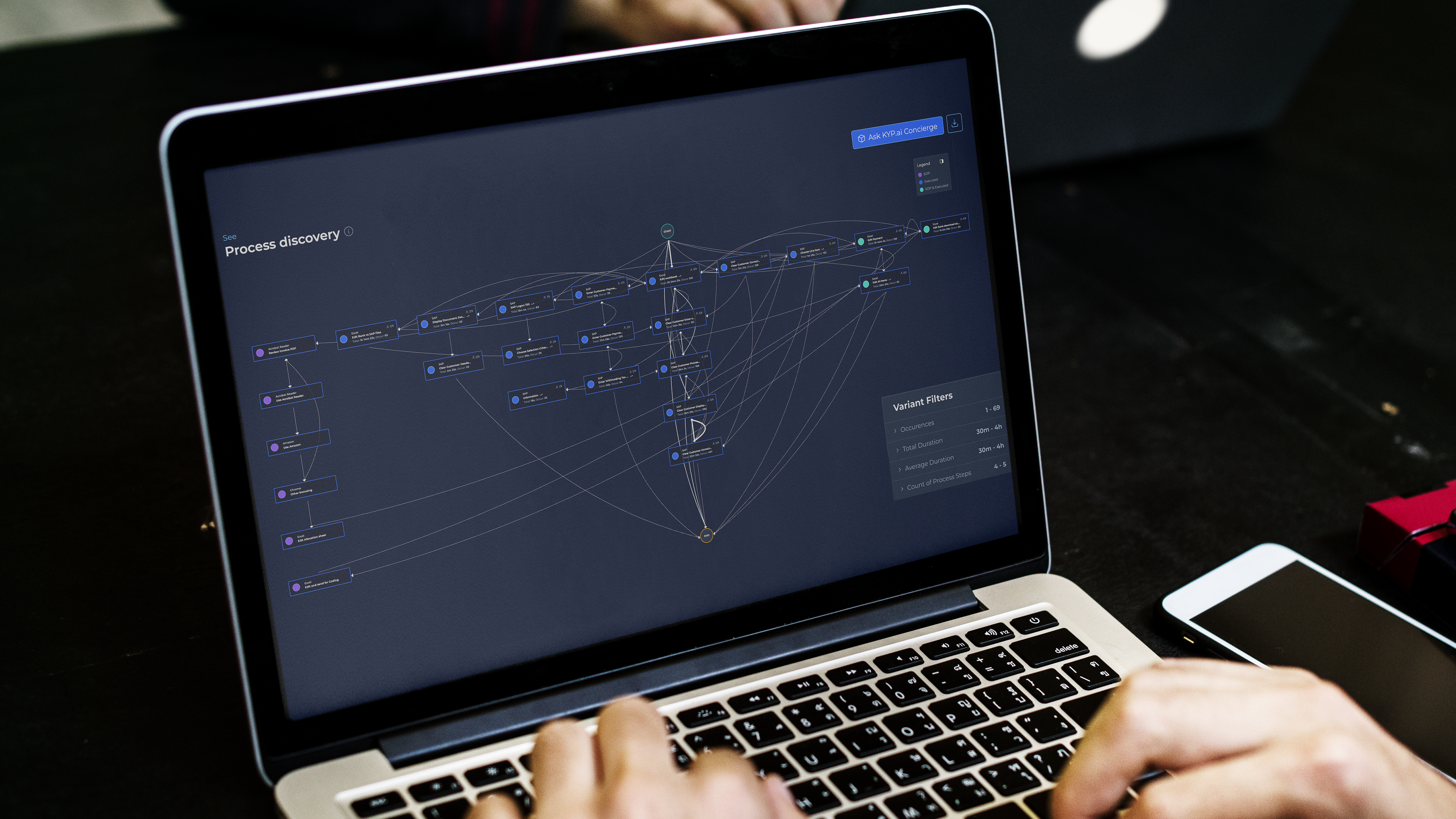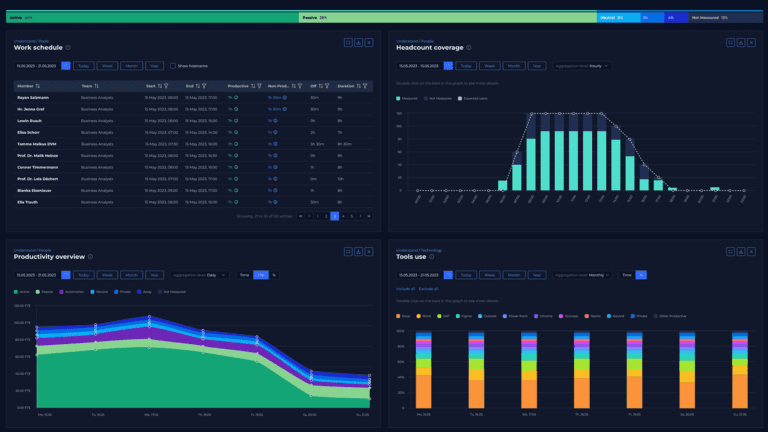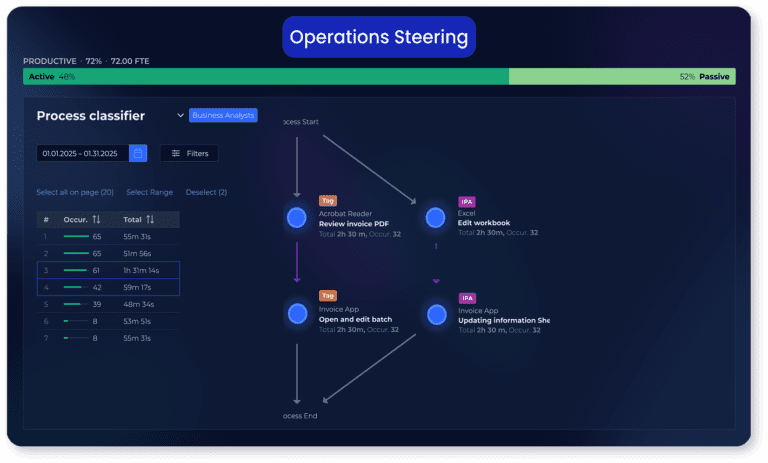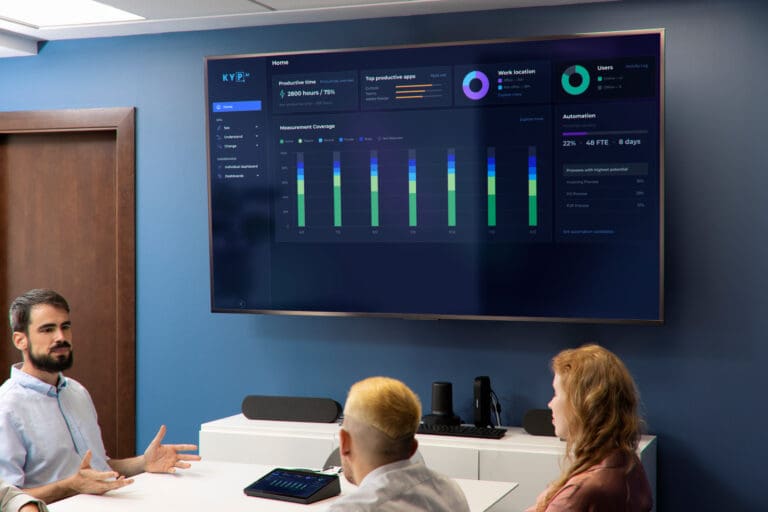Process mining has matured from niche analytics into a critical enterprise capability for operational excellence. 51% of large enterprises now use process intelligence solutions, with another 23% planning adoption.
As you seek to understand, optimize, and transform business processes, choosing the right process mining solution has become increasingly complex. Software comparison sites like G2 and Capterra track over 88 different solution providers.
This guide examines the leading platforms to consider today, with a focus on what distinguishes truly effective solutions from those with fundamental limitations.
What to expect from modern process mining solutions
Effective process mining platforms should deliver:
Automated process discovery
- Automated process model generation from operational data
- Visual process maps with variant analysis and bottleneck identification
- Root cause analysis linking process deviations to business outcomes
- Real-time and historical process monitoring
Seamless data integration and management
- Connections to diverse data sources across the enterprise
- Advanced configurability with data quality management
- Support for both structured and unstructured data beyond event logs
- Streaming data processing for near-real-time insights
Data-driven decision making
- Predictive analytics forecasting process outcomes
- Prescriptive recommendations for process improvements
- Simulation capabilities for scenario testing
- Object-centric process intelligence for interconnected processes
Link from insights to action
- Integration with automation platforms (RPA, workflow engines)
- Conformance checking against reference models
- KPI dashboards with customizable metrics
- Natural language interfaces for business users
The 10 best process mining solutions
1. KYP.ai – Best overall for modern process intelligence
Company background: KYP.ai represents the next generation of process intelligence software, purpose-built for modern organizations navigating complex application landscapes and hybrid work environments. Rather than constraining itself to traditional event log extraction from ERP systems, KYP.ai combines desktop capture technology with large language model (LLM) analysis and conversational AI to deliver fast, prescriptive insights that traditional process mining approaches simply cannot match.
Core approach: KYP.ai deploys a leading process intelligence suite that blends desktop capture with LLM-driven analysis and a conversational AI layer for fast and prescriptive insights. By combining next-generation process mining features with AI-powered analytics, the platform delivers continuous operational insights and automated process discovery ideally suited for digital transformation initiatives. Unlike legacy platforms focused on extracting event logs from backend systems, KYP.ai captures actual user behavior across all applications – providing visibility into the complete work reality rather than just system transactions.
Unique feature: KYP.ai is the only solution capable of generating agentic AI scripts usable in AI automation platforms like UiPath Studio and SAP Joule.
Three standout capabilities
- AI-driven automated insights: Leverages large language models to automatically analyze process data and generate prescriptive recommendations and agentic AI scripts, without requiring manual configuration or process mining expertise. The platform’s conversational AI layer allows business users to ask questions in natural language and receive actionable insights immediately.
- Real-time process monitoring: Provides continuous visibility into process execution as it happens, enabling organizations to identify and address bottlenecks, compliance violations, or inefficiencies before they impact business outcomes. Real-time alerting ensures process owners can respond immediately to emerging issues.
- Scalable capture across modern and legacy apps: Captures user activity across the entire application portfolio—from modern SaaS applications to legacy desktop systems—without requiring complex connector development or event log extraction. This comprehensive visibility reveals shadow IT usage, workarounds, and manual processes invisible to traditional mining approaches.
Three limitations
- More limited market presence vs established vendors: As a newer entrant compared to category leaders like Celonis or SAP Signavio, KYP.ai has a smaller customer base and may face perception challenges with conservative buyers prioritizing vendor longevity over innovation.
- Not the best option for ERP event log extraction and analysis: Organizations seeking deep, native integration with SAP or other ERP systems for traditional event log mining may find specialized solutions better optimized for that specific use case.
- Windows desktop deployment: Like all activity capture solutions, KYP.ai requires deployment across employee workstations, which may require skilful communication and change management approach.
Best for: Organizations seeking modern, AI-first process mining with quick deployment and real-time capabilities. Ideal for mid-market and enterprise companies beginning their process mining journey, those with diverse application landscapes beyond major ERP systems, or organizations prioritizing automation opportunity identification and hybrid work optimization over pure ERP process analysis.
2. Celonis – Best for traditional ERP data mining
Company background: Celonis pioneered commercial process mining and has grown into the category leader with the largest customer base, most extensive partner network, and most comprehensive platform capabilities in traditional process data mining.
Core approach: Celonis delivers an extensive process intelligence platform with object-centric process mining (OCPM) and a broad partner ecosystem, offering comprehensive process discovery and optimization at enterprise scale. The platform’s Celocore engine provides the foundation for OCPM-compliant analysis, enabling organizations to understand complex processes involving multiple interacting business objects rather than just linear case flows.
Three standout capabilities
- Extensive capabilities to extract event log data from different ERP Systems: Deep, pre-built integration with SAP, Oracle, Microsoft Dynamics, and other major ERP platforms with sophisticated extractors that handle complex data structures and accelerate deployment for system-centric process mining initiatives.
- OCPM-compliant platform: Implementation of object-centric process mining allows analysis of complex, interconnected processes where multiple business objects (orders, invoices, shipments, customers) interact.
- Large partner and integration ecosystem: Extensive ecosystem with pre-built connectors to hundreds of enterprise applications and a global network of implementation partners, system integrators, and technology partners providing deployment support and industry expertise.
Three limitations
- Complex pricing with multiple add-on SKUs: Pricing model involves multiple components, add-on capabilities, and tiered feature sets that can make total cost of ownership difficult to predict and potentially expensive as organizations scale usage or add advanced features.
- Steep learning curve for full functionality: Comprehensive platform with extensive capabilities requires significant training and expertise to utilize fully. Organizations may need dedicated Celonis specialists or rely heavily on partner services during implementation and ongoing operation.
- OCPM adds complexity for simple use cases: While object-centric mining is powerful for complex scenarios, it introduces analytical complexity that may be unnecessary for organizations with straightforward, linear processes who could benefit from simpler approaches.
Best for: Large enterprises requiring comprehensive, system-agnostic process mining with global support, extensive integrations, and advanced analytics capabilities. Particularly valuable for organizations with complex, interconnected processes and those willing to invest in the resources required for successful platform adoption.
3. SAP Signavio – Best for SAP Ecosystem Integration
Company background: SAP acquired Signavio in 2021 for $1.2 billion, integrating process mining and business process management capabilities into the SAP Business Technology Platform. Post-acquisition, SAP has invested heavily in connecting Signavio to the broader SAP ecosystem while maintaining its cloud-native, multi-tenant architecture.
Core approach: SAP Signavio provides a cloud-native process transformation suite focused on SAP ecosystems, emphasizing enterprise observability and digital twin of organization (DTO) capabilities with AI-assisted insights. The platform positions itself as the process intelligence layer for SAP customers, providing unique visibility into SAP-based operations with minimal integration effort.
Three standout capabilities
- Deep SAP ecosystem integration: Native connection to SAP systems with automated data extraction leveraging SAP’s intimate knowledge of its own data structures. SAP Process Insights provides plug-and-play connectivity to common SAP processes with minimal configuration required.
- Industry-specific benchmarks: Extensive library of process benchmarks across industries enables organizations to compare their process performance against peers and best practices, providing context for improvement initiatives and quantifying the gap between current and optimal performance.
- AI-assisted conformance and modeling: Generative AI capabilities help users identify conformance violations, suggest process improvements, and accelerate process modeling by generating BPMN models from natural language descriptions or discovered processes.
Three limitations
- No OCPM Support: Platform does not support object-centric process mining, limiting its ability to analyze complex processes involving multiple interacting business objects. Organizations requiring OCPM must look to alternative solutions.
- Confusion between intelligence vs insights products: SAP offers both “Process Intelligence” (the full Signavio suite) and “Process Insights” (simplified SAP-focused offering), creating market confusion about which product provides which capabilities and appropriate licensing for different use cases.
- Less value outside SAP ecosystem: While technically capable of mining non-SAP systems, the platform’s value proposition is strongest for SAP customers. Organizations with diverse, non-SAP-centric application landscapes may find better options elsewhere.
Best for: SAP customers seeking integrated process mining within their existing SAP landscape, with strong industry benchmarks and transformation focus. Particularly valuable for organizations looking to optimize SAP-based processes with minimal implementation friction.
4. Microsoft Power Automate – Best for Microsoft ecosystem
Company background: In 2022 Microsoft acquired a startup called Minit to integrate process mining into its Power Platform, making process intelligence capabilities accessible to its vast installed base of Power Automate, Power BI, and Microsoft 365 users. This democratizes process mining by positioning it within tools many organizations already use daily.
Core approach: Microsoft delivers low-code process mining integrated with the Microsoft ecosystem, featuring GPT-4o mini model integration and comprehensive automation observability across Azure and Power Platform. The platform emphasizes accessibility for business users through familiar Microsoft interfaces and seamless integration with existing workflows.
Three standout capabilities
- Deep Microsoft ecosystem integration: Native connection to Microsoft 365, Dynamics 365, Azure services, and thousands of Power Platform connectors creates minimal-friction deployment for Microsoft-centric organizations. Process insights flow naturally into Power BI dashboards and Power Automate workflows.
- GPT-4o Mini Integration for Conversational AI: Embedded AI assistant powered by GPT-4o mini enables business users to ask questions about processes in natural language, generate insights without technical expertise, and receive guided recommendations through conversational interaction.
- Unified low-code platform with RPA/IDP: Combines process mining with robotic process automation (Power Automate Desktop) and intelligent document processing in a single low-code environment, enabling rapid progression from process discovery to automation implementation.
Three limitations
- Limited non-Microsoft use case support: While Power Platform connectors provide broad connectivity in theory, practical process mining use cases and pre-built analytics are heavily weighted toward Microsoft applications, with limited out-of-box support for non-Microsoft processes.
- No OCPM implementation: Microsoft announced object-centric process mining plans over two years ago but has not yet delivered the capability, leaving customers requiring OCPM without a solution timeline.
- No on-premises deployment option: Cloud-only offering may not be suitable for organizations with regulatory requirements, data residency concerns, or policies requiring on-premises deployment of analytical tools.
Best for: Microsoft-centric organizations wanting seamless integration with Azure, Power Platform, and Office 365, prioritizing ease of use over advanced features. Ideal for organizations with limited process mining expertise seeking accessible tools within familiar Microsoft environments.
5. UiPath Process Mining – Best for automation-focused organizations
Company background: UiPath entered process mining through its 2021 acquisition of ProcessGold, integrating process intelligence with its market-leading RPA platform. This positions UiPath to offer end-to-end automation discovery and deployment within a unified platform.
Core approach: UiPath provides an automation-focused platform combining process, task, and communications mining with GenAI assistance, targeting global enterprises with strong RPA integration capabilities. The platform emphasizes discovering automation opportunities and measuring automation performance within the broader UiPath ecosystem.
Three standout capabilities
- Integrated task and communications mining: Unique combination of system-level process mining, desktop-level task mining, and AI-powered communications mining (analyzing emails, chats, and other unstructured text) provides comprehensive visibility across all levels of work execution.
- UiPath Autopilot: Generative AI assistant enables business users without process mining expertise to explore processes, ask questions in natural language, and receive automated recommendations for process improvements and automation opportunities.
- AI trust layer for responsible AI: Governance framework ensuring AI-generated insights and recommendations are explainable, auditable, and compliant with organizational policies. Particularly valuable for regulated industries requiring transparency in AI-driven decision making.
Three limitations
- No OCPM support: Platform does not support object-centric process mining, limiting analysis to traditional case-centric approaches and constraining visibility into complex processes involving multiple interacting business objects.
- Complex and expensive pricing: Enterprise-grade pricing structure and licensing model may be prohibitive for small and mid-sized organizations, with costs potentially exceeding value realization for companies without substantial automation programs.
- Automation-focused: Platform optimization for RPA use cases means general process optimization, compliance, or transformation initiatives may not receive the same depth of capability as automation-focused scenarios.
Best for: Enterprises prioritizing intelligent automation and RPA, seeking unified discovery of process, task, and communication patterns with strong governance. Particularly valuable for organizations already invested in or committed to the UiPath automation platform.
6. IBM Process Mining – Best for prescriptive AI and hybrid cloud
Company Background: IBM entered process mining through its 2021 acquisition of myInvenio, integrating the technology into its Cloud Pak for Business Automation suite. This positions process mining as a component of IBM’s broader intelligent automation and AI strategy, with deep integration to watsonx and other IBM technologies.
Core Approach: IBM delivers an enterprise platform with OCPM support, prescriptive AI, and watsonx integration, delivered via Red Hat OpenShift for hybrid cloud deployments. The platform emphasizes AI-driven recommendations and industry-specific solutions for complex enterprise environments.
Three standout capabilities
- Full OCPM compliance: Advanced object-centric process mining capabilities combined with AI-powered prescriptive analytics that not only identify process issues but recommend specific actions with quantified expected benefits and implementation guidance.
- Industry-specific knowledge: Pre-built process analytics, KPIs, and best practices for specific industries (financial services, healthcare, telecommunications, manufacturing) accelerate deployment and provide industry-relevant insights without requiring custom development.
- Data-driven simulation capabilities: Sophisticated simulation engine allows testing process changes before implementation, modeling resource allocation scenarios, and quantifying improvement potential through what-if analysis with confidence intervals.
Three limitations
- Steep learning curve for non-technical users: Platform complexity and enterprise-grade capabilities require significant technical expertise. Business users may struggle without dedicated process mining specialists or heavy reliance on IT support.
- Complex on-premises pricing: Pricing for on-premises and hybrid cloud deployments involves multiple components (infrastructure, licenses, support) that can make total cost of ownership difficult to predict and potentially expensive.
- Focus on automation gver general mining: Like UiPath, IBM’s positioning within intelligent automation means general process optimization or transformation use cases may receive less emphasis than automation-focused scenarios.
Best for: Large enterprises needing prescriptive recommendations, industry-specific solutions, and hybrid cloud flexibility with strong IBM ecosystem integration. Particularly valuable for organizations with existing IBM technology investments or those in regulated industries requiring on-premises deployment options.
7. ServiceNow Process Mining – Best for ServiceNow deployments
Company background: ServiceNow integrated process mining capabilities directly into its platform to provide visibility into IT service management (ITSM) workflows and enterprise service operations. This native integration positions process mining as a natural extension of ServiceNow’s platform for organizations already using it for service management.
Core approach: ServiceNow offers a platform extension providing native ServiceNow integration with predictive analytics and GenAI summarization, primarily for IT service management workflows. The solution emphasizes ease of deployment for ServiceNow customers and immediate visibility into platform-based processes.
Three standout capabilities
- Native ServiceNow platform integration: Seamless connection to ServiceNow workflows, cases, and tickets without requiring external connectors or data extraction. Process mining operates within the ServiceNow environment customers already know.
- Guided setup for quick insights: Simplified onboarding experience with pre-configured process analytics for common ITSM workflows (incident management, change management, service requests) enables rapid time-to-value without extensive configuration.
- Real-time KPI monitoring: Continuous visibility into process performance with real-time dashboard updates and alerting ensures service level agreement (SLA) compliance and enables proactive intervention before issues escalate.
Three limitations
- Limited standalone adoption: Platform is primarily valuable for existing ServiceNow customers; organizations without ServiceNow deployments would not choose this solution, limiting its addressable market to the ServiceNow installed base.
- Few non-ITSM use case assets: While technically capable of mining broader processes, pre-built analytics and accelerators focus heavily on IT service management use cases. Support for non-ITSM processes requires more custom development.
- Complex ETL for external processes: Mining processes that extend beyond ServiceNow (e.g., involving SAP, Salesforce, or other external systems) requires traditional ETL development and data integration, reducing the benefit of native platform integration.
Best for: ServiceNow customers wanting to extend process visibility within their existing ITSM and enterprise workflows without additional platforms. Particularly valuable for IT operations teams seeking to optimize incident, change, and service request processes.
8. ARIS – Best for governance, risk, and compliance (GRC)
Company Background: ARIS (now part of Software AG) has been a major player in business process management since the 1990s, with deep heritage in process modeling, enterprise architecture, and governance. The company added process mining capabilities to create an integrated process transformation platform.
Core approach: ARIS serves as a traditional EBPA (Enterprise Business Process Analysis) leader offering dual task mining approaches (SaaS and on-premises) with strong GRC (governance, risk, compliance) integration and prescriptive analytics capabilities. The platform combines bottom-up process discovery with top-down process design and governance frameworks.
Three standout capabilities
- GRC and compliance features: Deep integration with governance, risk, and compliance frameworks enables continuous compliance monitoring, risk assessment, and audit trail capabilities that go beyond process optimization to address regulatory requirements.
- DMN support: Decision Model and Notation (DMN) support allows linking process mining insights to decision logic, providing prescriptive recommendations based on industry best practices and organizational rules.
- Two task mining solutions (ProcessMaker/Nintex): Unique approach offering both SaaS-based task mining (via ProcessMaker) and on-premises task mining (via Nintex) to accommodate different organizational requirements, regulatory constraints, and deployment preferences.
Three limitations
- High learning curve for new users: ARIS’s comprehensive scope and enterprise heritage create interface complexity that can overwhelm new users or organizations without dedicated process management expertise.
- Recent demerger may impact support: Software AG’s recent demerger and restructuring creates potential uncertainty about product roadmap, support continuity, and long-term investment in the ARIS platform.
- Focused on existing ARIS accounts: Sales and marketing efforts primarily target organizations with existing ARIS deployments, making it less accessible or attractive for organizations new to the ARIS ecosystem.
Best for: Organizations with established ARIS deployments seeking integrated process mining for governance, risk, compliance, and enterprise architecture. Particularly valuable for highly regulated industries requiring robust audit trails and compliance documentation.
9. Pegasystems – Best for unified process discovery and automation
Company background: Pegasystems has been a leader in business process management and case management software for decades. The company integrated process mining to complement its workflow automation and low-code application development platform, enabling data-driven process optimization alongside process execution.
Core Approach: Pega delivers a cloud-only intelligent automation platform with GenAI Blueprint integration, combining process and task mining with workflow automation capabilities. The platform emphasizes rapid translation from process discovery to automated workflow implementation.
Three standout capabilities
- GenAI Blueprint: AI-powered workflow design tool converts discovered processes and business requirements into Pega application designs automatically, dramatically accelerating the journey from discovery to implementation.
- Quick data refreshes: Rapid release cadence ensures continuous innovation and quick access to new capabilities, with quarterly major updates bringing new features based on customer feedback and market evolution.
- Extensive partner network: global network of implementation partners, system integrators, and consultants provides deployment support and industry expertise across geographies and verticals.
Three limitations
- No on-premises deployment: Cloud-only offering may not meet requirements for organizations with data residency concerns, regulatory constraints, or policies mandating on-premises deployment of business-critical platforms.
- No OCPM support: Platform does not support object-centric process mining, limiting analysis to traditional case-centric approaches for organizations with complex, interconnected processes.
- Automation-focused positioning: Platform optimization for workflow automation and case management means general process optimization or pure analytical use cases may not receive the same depth of capability.
Best for: Enterprises seeking unified process discovery and automation with strong partner support, particularly in financial services and government. Most valuable for organizations building custom applications or complex workflows on the Pega platform.
10. iGrafx Process360 – Best for combined mining, modeling, and simulation
Company background: iGrafx has decades of experience in process modeling and simulation, evolving from a pure modeling tool into a comprehensive process intelligence platform. The company combines traditional strengths in process design with modern mining and AI capabilities.
Core approach: iGrafx provides a process intelligence platform with GenAI assistant Pia, bundling mining, design, and optimization with predictive analytics for compliance detection. The platform emphasizes the complete process lifecycle from discovery through design and continuous improvement.
Three standout capabilities
- Integrated simulation capabilities: Deep simulation capabilities allow testing process changes, resource allocation scenarios, and improvement initiatives before implementation, quantifying expected benefits with confidence.
- GenAI-Powered Pia Assistant: Conversational AI assistant helps users navigate the platform, answer questions about processes, generate insights, and provide recommendations without requiring deep process mining expertise.
- iGrafx University training platform: Comprehensive learning and certification program ensures users can maximize platform value through structured training, best practices, and ongoing skill development.
Three limitations
- No OCPM support: Platform does not support object-centric process mining, constraining analysis to traditional case-centric approaches for complex processes involving multiple interacting business objects.
- Lacks pre-built templates: Limited pre-built process analytics, industry benchmarks, or vertical-specific templates compared to larger vendors, requiring more custom development for industry-specific use cases.
- Smaller partner network: Direct support and services concentrated in North America and Europe; organizations in other regions must work through channel partners, potentially impacting support responsiveness.
Best for: Process excellence teams in BFSI (banking, financial services, insurance), healthcare, and manufacturing seeking combined mining, modeling, and simulation capabilities. Particularly valuable for organizations prioritizing process design and what-if analysis alongside discovery.
Key use cases for process mining
- Process discovery & optimization. Understanding actual process flows versus intended designs, identifying inefficiencies, and quantifying improvement opportunities.
- Compliance & audit validating. Adherence to regulatory requirements, internal policies, and best practices through continuous conformance checking and segregation-of-duties analysis.
- Automation opportunity identification. Discovering high-value automation candidates by analyzing process patterns, task repetition, and manual work that could be eliminated or streamlined.
- Digital transformation. Linking strategic initiatives to operational reality, assessing transformation impact, and creating data-driven roadmaps for enterprise modernization.
- Application modernization. Understanding dependencies across application landscapes, assessing the impact of system changes, and identifying Agentic AI automation opportunities.
How to choose your best-fit process mining solution
Data access strategy: event logs vs. work reality
The most fundamental decision in selecting a process mining platform is understanding what data it can actually analyze and whether that aligns with where your process insights actually exist.
Traditional event log mining extracts data from enterprise systems (ERP, CRM, etc.) and analyzes what those systems recorded. This approach is well-established and works when:
- Your processes execute primarily within major business systems
- You’re analyzing well-structured, system-mediated workflows
- You’re focused on system-level process optimization
However, event logs fundamentally miss what matters most in many modern processes:
- Work across multiple applications not integrated at the data level
- Manual tasks in email, Excel, or desktop applications
- Workarounds and shadow IT usage
- The actual user experience of executing processes
User activity-based mining (like KYP.ai’s approach) captures how people actually work across all applications, revealing the complete process picture. This is essential when:
- Your processes span multiple disconnected systems
- You need to understand actual work patterns vs. system transactions
- You’re identifying automation opportunities in manual work
- You’re optimizing hybrid work or application portfolio
Decision point: If your goal is optimizing SAP processes, traditional mining works. If you need to understand how work actually happens across your entire digital workspace, activity-based approaches are necessary.
Implementation complexity and time-to-value
Process mining initiatives fail or stall more often due to implementation complexity than inadequate algorithms.
Consider:
- Data engineering requirements: How much effort is required to extract, transform, and prepare data? Traditional mining often requires dedicated data engineers for months.
- Connector availability: Pre-built connectors accelerate deployment but may not cover your specific systems. Evaluate both breadth and depth.
- Infrastructure demands: Cloud-native solutions deploy faster than on-premises platforms requiring hardware and IT coordination.
- User adoption barriers: Technical interfaces requiring process mining expertise limit impact. Natural language interfaces and pre-built analytics democratize insights.
Decision point: Calculate realistic time-to-first-insight. A platform promising 90% of value in 10% of deployment time may serve you better than one delivering 100% of value after 9 months of implementation effort.
Scope: point solution vs. platform play
Focused process mining tools offer deep analytical capabilities but require integration to drive action. Broader automation platforms provide integrated discovery-to-execution but may sacrifice process mining depth.
Evaluate based on your organizational context:
- Existing technology investments: Integration with current platforms (RPA, BPM, low-code) can accelerate value realization
- Strategic direction: Are you building a unified automation platform or assembling best-of-breed capabilities?
- Resource availability: Platform approaches may simplify operations; point solutions may require orchestration capabilities
Decision point: A best-of-breed process mining tool might deliver superior analytics but create integration burden. A platform approach might simplify operations but limit flexibility.
Object-centric vs. case-centric mining
Traditional case-centric process mining analyzes processes from the perspective of a single business object (e.g., an order, a claim, a ticket). This works when processes are linear and organized around a primary case.
Object-centric process mining (OCPM) analyzes processes involving multiple interacting business objects (orders, shipments, invoices, customers). This is essential for:
- Complex supply chain processes
- Quote-to-cash processes spanning sales, delivery, and finance
- Any scenario where multiple object types interact
Decision point: Evaluate whether your processes are truly case-centric or involve multiple interacting objects. OCPM is emerging as critical for complex enterprise processes but adds analytical complexity.
Total cost of ownership
Look beyond license costs to implementation, integration, infrastructure, and ongoing management expenses.
Hidden costs include:
- Data engineering and preparation: Often the largest cost in traditional mining implementations
- Infrastructure: On-premises solutions require hardware, maintenance, and IT resources
- Implementation services: Many vendors require certified partners for deployment
- Training and enablement: Technical platforms need ongoing skill development
- Integration maintenance: Connections to data sources require updates as systems evolve
Decision point: A platform with a higher per-user license cost but pre-built analytics and minimal data engineering may deliver lower TCO than a cheaper solution requiring extensive customization.
Bottom line on selecting process mining software
The process mining market has matured significantly, with multiple capable solutions available for different organizational needs. However, a fundamental divide persists between platforms that analyze what systems record and those that capture what people actually do.
Traditional event-log mining platforms (like Celonis and SAP Signavio) have sophisticated algorithms and enterprise-grade capabilities. They excel at analyzing processes that execute within major business systems and provide valuable insights for system-level optimization.
However, these approaches share a fundamental limitation: they only see what enterprise systems record. In an era of hybrid work, disconnected applications, and knowledge work spanning multiple tools, this constraint means traditional mining misses the majority of actual process execution. The work happening in email, Excel, Slack, and dozens of other applications where event logs don’t exist.
KYP.ai’s Productivity 360 represents a fundamentally different approach: capturing process intelligence from user activity across all applications rather than system event logs. This methodology reveals the complete picture of how work actually happens, including the manual effort, workarounds, and cross-application workflows that traditional mining cannot detect. Your selection should be driven by three questions:
- Where do your processes actually live? If primarily within major ERP systems, traditional mining suffices. If spanning multiple applications and involving significant manual work, activity-based approaches are necessary.
- What outcomes do you need? System-level process optimization works with traditional mining. Understanding and optimizing actual work patterns requires visibility into user activity.
- How quickly must you generate value? Platforms requiring extensive data engineering extend time-to-insight. Solutions with pre-built analytics and automated data collection accelerate realization.
Choose a platform that reveals not just what your systems record, but what your people actually do. The insights you can’t see will matter more than the sophisticated analysis of incomplete data. To see the difference, book a demo with KYP.ai today.
Discover Your Productivity Potential – Book a Demo Today
Book Demo








